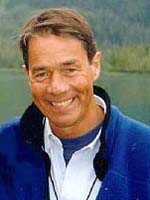Tony KnowlesDemocratic candidate for governorQuestion: Aviation is a key component of the state transportation system. What would your administration do to support the 258 airports operated by the Department of Transportation and Public Facilities (DOTPF)? Answer: Those 258 airports serve both commercial and general aviation, and as such they play a critical role in the state's economy and in the fabric of Alaska. My support for these facilities will recognize their importance to Alaska's transportation infrastructure. As governor, I will ensure the DOTPF has sufficient funding to operate and maintain state-owned airports. That level of support means we will take advantage of all available federal funding for upgrading and expanding airport facilities. I am also concerned that air transportation responsibilities have been spread too diffusely in the department, and my administration will take steps to centralize policy and planning. I am looking closely at the suggestion to reorganize DOTPF through a modal (as opposed to functional) structure — highway, marine, and aviation. Alaska is best served when aviation receives departmental advocacy and support commensurate with its importance. I have been impressed with both the Capstone and Medallion programs, and my administration will continue to support technological upgrades to assist general aviation safety. For example, 95 of DOTPF's airports have no runway lights, and we can and should make better use of remote weather cameras and GPS. Question: Beyond the airports operated by the Department of Transportation and Public Facilities (DOTPF), there are many remote airstrips on state land that are important for recreation, mineral exploration, guiding, and other uses. They also serve as emergency landing areas when the weather changes unexpectedly. What would your administration do to protect and preserve these airstrips? Answer: As someone who has spent a lot of time in small planes flying over this state, I understand the importance of these airstrips. As governor I will work closely with the aviation community on the best ways to protect them. At the outset, that means generating a more thorough inventory of those strips. It also means taking greater care and exercising more careful planning with land disposal programs. We will make certain that remote airstrip preservation has an appropriate mandate in Department of Natural Resources planning and, where it makes sense, transfer responsibility for some strips from the DNR to the DOTPF. The Gold King airstrip transfer serves as an example of this sort of transfer, although we would work for a faster and more streamlined process than occurred in that instance. In addition, I am supportive of recently passed state law, which allows communities and aviation groups to maintain airstrips without fear of incurring liability. | |
Sarah PalinRepublican candidate for governorQuestion: Aviation is a key component of the state transportation system. What would your administration do to support the 258 airports operated by the Department of Transportation and Public Facilities (DOTPF)? Answer: Aviation is a very important mode of transportation in Alaska. I recognize that most of Alaska is roadless and that maintaining a system of airports is a life and health issue for many communities. I do understand that the Anchorage and Fairbanks airports are part of a separate system, in which the cost of operating them and the cost of new upgrades and maintenance are a separate cost center, like an enterprise fund, and the costs are borne by the airlines that operate at those facilities. The importance of the international cargo and the traveling public to and from Alaska through these facilities is reflective in the economic gains that are enjoyed by the residents of those communities. The balance of the state airport system is equally important to the very livelihood of those communities by providing a system of transportation to rural Alaska. The state must continue to operate the rural system, and continue to construct and upgrade these airports to allow for passenger and freight service. The state provides an average of $200 million a year for upgrades and for new or reconstruction of our airports, mostly federal Airport Improvement Program funds. This is a vital system that the state must continue to maintain. My administration will work toward an increase in federal funds, matched with general funds, to increase the improvements of our airports. I also recognize that deferred maintenance, and other projects that are not eligible for federal funding, must be addressed. My administration will have an open dialogue with the pilots and organizations like AOPA, and I will direct the DOTPF to work as closely with you as possible on prioritizing what needs to be done. Question: Beyond the airports operated by the Alaska Department of Transportation and Public Facilities (DOTPF), there are many remote airstrips on state land that are important for recreation, mineral exploration, guiding, and other uses. They also serve as emergency landing areas when the weather changes unexpectedly. What would your administration do to protect and preserve these airstrips? Answer: Along with the 258 airports that the state currently has in its system, there are many other airports and landing strips that are in the inventory of the Department of Natural Resources, and some might be in the ownership of the Bureau of Land Management. The most important of these airstrips must be cataloged, and the land designated as airstrips. These new airstrips can then be operated by the users, either recreational users, miners, or whoever is the appropriate operator. I believe, if done correctly, the state could do something to create a situation in which the users could actually purchase the land adjacent to the strips, to provide land sales and more access to the areas. This would require legislation to authorize such sales and uses, and the facilities would not be eligible for any federal funding, but possibly some of the land sales revenue could be granted back to the owners for part of the maintenance. I will be seeking the advice of your organization as to which airstrips should be included, and also if there are emergency airstrips that should be upgraded and added to the state's rural system. |
October 18, 2006


